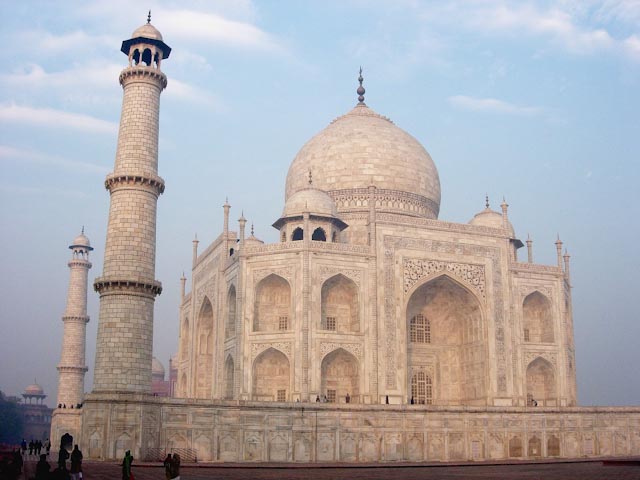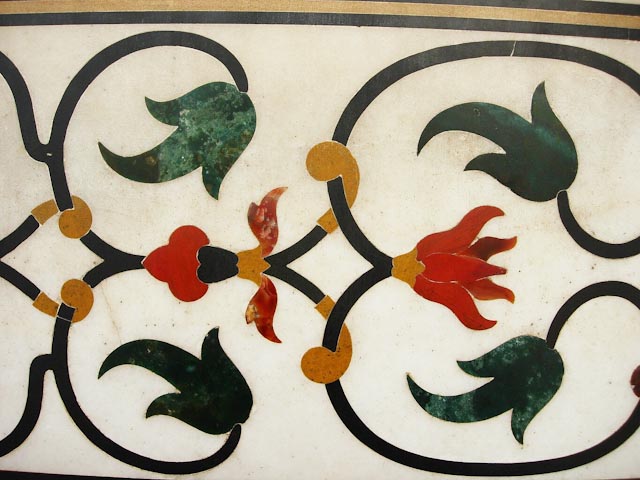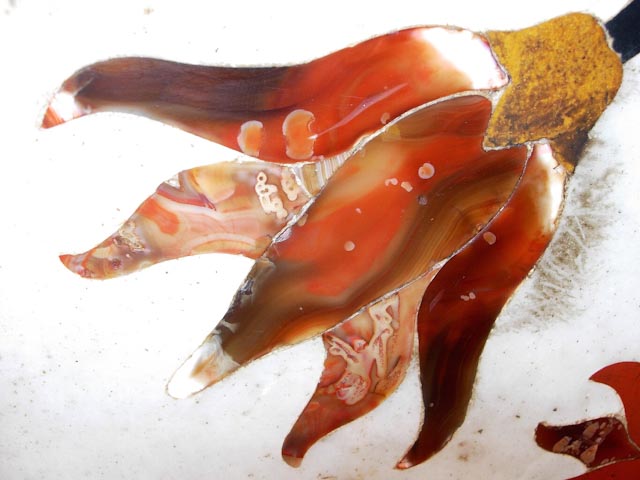We have left Rajasthan and now find ourselves in UP (Uttar Pradesh). The scenery is becoming more lush and more widely cultivated. We pass many fields of mustard plants that remind me of the solid yellow rapeseed fields in Switzerland. The fields that aren’t bright yellow are bright green with wheat. Also more prolific now are the stacks and rows of drying cow patties. We pass them in circular fortress structures and in rows like plates in a drying rack. Every small house and shack has a huge pile of them. The significance of this would not strike me until later.
We enter the outskirts of Agra and some of the group note with surprise that this does not seem to be the wealthy town we might have supposed, given it possesses one of the world’s most famous and popular tourist attractions. Later, we notice tourism promotions trying to sell Agra as a three-day destination, but no one seems convinced.
I have also had a lucky break, although it didn’t feel lucky at the time. I have never exceeded the capacity of my camera’s memory card and had no idea what it would absorb. Just before my battery died at Fatehpur Sikri, it overloaded. If the battery had died beforehand I would have turned up to the Taj with a recharged camera with no space. Ack. Doesn’t bear thinking about. So I rushed out into the night to find a mall (yes, there was one, complete with McDonalds) where I could get a card. It was a very short walk but the exposure to the pollution in that limited window of time had me coughing up a lung for the rest of the night.
Most of the group has been suffering runny noses at best, and congested lungs and restricted breathing at worst. Some of us have taken on the Japanese tourist look with bandit masks over our faces. I also think I’m suffering from a terrible head start on the rest of the group with my initial week in Delhi. It took me several less-polluted locations to stop blowing copious amounts of blood in the mornings and shooting missiles into my hanky, and even then, those places had dust as a replacement problem. Now Agra has me coughing like a tubercular Brontë and I wonder if I am causing some lasting damage. I would certainly recommend asthmatics think twice before coming here, or to at least review the larger cities on their itinerary and/or the time of year. Winter is the worst, which brings me back to those cow patties.
The traffic no doubt creates its fair share of muck in the air; however, it is the coal and cow patty fires that cause the most grief, I think. Poorer people (ie the majority of folk) use this fuel to cook and to warm themselves, which also explains why the mornings and evenings are the worst times for smog. It also hangs thick and pungent in the air. We often see signs in cities promoting ‘Clean and Green’ strategies but they don’t seem to make a lot of impact. For example, we have been to a couple of sites where we have had to transfer to CFG buses. After driving a kilometre, we transfer to a CFG bus for the remaining kilometre to the Taj Mahal. A farcically symbolic gesture, but at least they acknowledge there is a problem. Unfortunately, attacking the worst of it by converting poor families to environmentally friendly fuel would be massively expensive for the government and boggles the mind just contemplating the logistics. This problem extends from the heart of India’s key issue: extensive rural poverty. Don’t expect a quick fix any time soon.
So we come at last to the star turn of this tour. Whilst we didn’t beat the early morning cow patty fumes, we did get out before the sparrows started farting. We squint through the cocktail of fog, smoke, dust and pollution and worry about the Taj’s visibility. We pile out of our bus and confront a gargantuan red stone gateway that we must pass through to enter the grounds proper. Through the dark entry hall of the gate we finally visually grasp the outline of the dome and its four surrounding minarets.
Already the place is crawling with people and it’s only 7am. Sunrise is due at 7.15am so there are hopes that the sun may burn off some of the fugginess. The whole scene is in varying shades of white to grey with an anaemically turquoise reflecting pool in the foreground surrounded by verdant manicured lawn. It is hard to believe the Taj is only about 100 metres away; the visibility is so poor. I take a few sanguine shots, knowing I will be doing a lot of culling later.
Everyone wants their shots from the centre. Given that the raison d’être of the Taj revolves around perfect symmetry and balance, this is fair enough, but it does cause a bit of waiting and it doesn’t take long to witness the first snappy words hurled between shooters. Some people are just content to sit and drink in this building’s undeniable majesty, although this conflicts with the rush-rush-get-that-snap-rush-to-the-next-spot mentality you encounter all the time. It is a shame, as this place really encourages navel gazing.
As I slowly walk and shoot my way up the length of the reflecting pool, the crowd thins out. It is easy to tell where the ‘classic’ vantage points are as the snappers and posers accumulate at them like ants on drops of honey.
The light is improving by microscopic degrees and by the time I achieve the middle platform there is a delicate hint of blue in the sky. Here is the spot. Already the premium romantic spot for lovers to pose, the central marble seat’s fame rocketed further when Princess Diana posed alone and communicated her love-lorn ‘singleness’ to the world.
The quotient of Indian tourists far outnumber the German, Japanese and other varieties of non-Indians snapping away. Vishnu be praised, the touts are not allowed in here or it would be intolerable.

I manage a couple of well-framed pictures although they look completely bleached of colour. As I approach the building itself, the photographic options are starting to become more interesting and far less clichéd. On either side of the tomb there are large buildings in red sandstone. The left-hand edifice is a working mosque. The grounds of the Taj are closed every Friday so that ordinary people can worship here. On the right there is a building used for hosting events. Both of these buildings have floral engraving and some marble inlay work, and are quite stunning in their own right, but they can only look like the ugly stepsisters next to the Taj.
The four minarets surrounding the Taj are enormous when seen from their bases. You can also perceive a slight outward leaning of these towers, which causes a visual correction of the resulting parallax when viewed from afar.
I mount the steep steps and finally I am at the entrance of the room that houses the mock-up tombs of Mumtaz Mahal and her husband Shah Jahan (their real tombs are down in the basement and not for viewing). No photos are allowed inside (pictured below are the lesser detailed patterns on the outside of the building) although some bright sparks brought torches, as the light is still quite feeble and what little there is, is blocked by people walking in and out of the one ingress/egress point.
The semi-precious stone inlays are incredibly fine and regular. Tulips, poppies, hyacinths and arabesque designs form the majority of the patterns that weave their way up the marble screens. The dominant colours on the outer doorframe are red, green and black, with some white rippled with pinky-browns. The stones are jasper, carnelian, malachite, agate, topaz, onyx, and I even notice a little bit of blue lapis.


Inside, the designs are even more intricate and each flower rewards intensive study. A rose-like flower that would fit in the hollow of my palm contained roughly 50-60 separate pieces of stone and the colours are artfully graded into each other. Another design, a tri-pronged flower where the heads were the size of my little fingernail, contained about eight pieces each and in addition three narrow slivers for stamens. I did not encourage the torch bearers as I didn’t want to be bothered with financial transactions in there, but the few flashes I noticed lit the stone up in a gorgeously translucent manner. Truly stunning.
The regularity and uniformity of the work are also amazing. The only variations to be seen are where the stone itself has unique colour variations. The pieces are all cut precisely to fit in the grooves and niches prepared in the white marble slabs. Now I am starting to comprehend the magnitude of this work. It took 20,000 people from all over Asia 22 years to complete. I reckon the fussing around on one flower could take at least a week, assuming no mistakes! Craftsmen came from as far away as Europe to produce these screens and it is said that some later had their thumbs or hands amputated to ensure they did not replicate this beauty anywhere else. Well, that makes a change to the gold watch approach to retirement.
So here lies Mumtaz Mahal, dead at 39 bearing her 14th child. It was not hubby’s plan to lie with her though (which explains why his tomb, placed to one side of his wife’s in the centre, creates the only offence to symmetry in the whole complex); he had even grander ideas. Jahan intended, in keeping with the principles of symmetry and balance, to erect exactly the same monument on the opposite bank of the Yamuna River in black marble for himself. But Aurangzeb, Jahan’s son, who would rampage his way into a large page of India’s history himself, took umbrage at Jahan’s joining the SKI Club (Spend the Kid’s Inheritance) before the Baby Boomers made it more acceptable hundreds of years later. The Treasury was being bled dry to finance Jahan’s fanciful aggrandisements, so son-o had Dad locked up in the Agra Fort, where he spent the last eight years of his life gazing over the river at his eternal gift to India’s future tourism coffers.
Probably just as well, really. The Taj is a pearl on its own and the lily truly would have been gilded with a black twin, assuming the money kept coming and Shah Jahan managed to keep his cheese from slipping off the biscuit. Still, having been boggled by the Taj’s size and structure as well as its intricate and precise detail, it is fun to imagine what it would have been like.

Comments
Total Comments : ( ) You have to register to post a comment.
RECENT COMMENTS